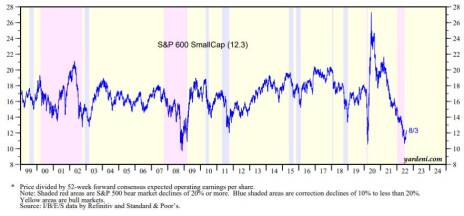Everyone wants to know what to expect from the Fed going forward. With incoming data anything but straightforward the Fed is trying to thread the needle ever so gently to guide the economy down to a soft landing.
Given massive market implications as a result of its actions, let’s get into the weeds of the Federal Open Market Committee (FOMC) workings for a minute and talk about what they’re expected to do.
After hiking rates by 75bps at the most recent meeting, the market is anticipating a 50-75bps rate hike at the next meeting in September, according to the CME’s FedWatch Tool. That hike would imply a target rate of 275-300bps or 300-325bps after the next meeting.
[text_ad]
Although it’s still over a month out, it would be a little crazy for the Fed to surprise to the upside in the current environment, especially given that two new additions to the FOMC (Susan Collins and Michael Barr) that ever so slightly tilt the balance toward the dovish end of the spectrum, at least in the short-term.
The bottom line is the market appears to be pricing in expectations that the Fed will might their foot off the gas (at least a little) and could potentially step back from the pattern of 75bps rate hikes.
What to Expect from the Fed Going Forward
If we pan out and look at the dot plot, which shows FOMC participants’ assessment of the “right” rate in the future, we see that the median projection for 2022 is about 3.35%, slightly lower than the implied year-end rate of just over 3.5% (indicated by the red dot).
The implied cadence here is that the Fed hikes another 75bps (or maybe 50bps) in September taking the target rate up to 300 – 325bps, then makes smaller hikes of around 25bps in November and/or December.
Looking out into 2023 the median projection is just a fraction higher at around 3.65%, but the market is actually expecting the Fed to cut. See how the red dot is at about 3.15%?
Then we go down again in 2024 and over the long-term.
What do all these dots tell us?
One interpretation is the market sees a looming recession and a Fed that needs to slash rates. Or, a scenario in which inflation does come back in and higher rates aren’t needed. Or some combination of the two.
Not mentioned yet but another major factor is the Fed’s handling of the balance sheet. It aims to trim it and that will influence rates as well. Right now it is slashing Treasury and agency-backed securities at a rate of $30 billion and $17.5 billion a month, respectively. And those amounts are set to double in September.
If your eyes haven’t rolled over into the back of your head yet (mine have) then consider this – if the Fed is able to engineer the so-called soft landing and we get no recession (or a very mild one), inflation comes down and the 10-year yield sticks at around 3% (give or take) then there is absolutely room for the market to rip higher, probably led by growth and small-cap stocks.
I’m not saying this is going to happen, just that it is a possible scenario. We’ve seen the market open up to this possibility this week.
These are the types of stocks that have been hurt the most because of “runaway” inflation and rate-hike shocks. It’s almost always the worst-performing groups that bounce back the most when the market turns up after a correction.
One area of high growth, software stocks are trading below their five-year trailing averages (using enterprise-value to forward revenue multiples), and roughly around their previous five-year (i.e. five - 10 years ago) trailing average. There are ways to slice and dice that data (i.e. new IPOs in the mix or not, higher growth groups vs. lower growth groups, etc.) but big picture, these stocks are no longer expensive.
Also, as I’ve said several times in recent weeks small-cap stocks are trading at a discount, and have been for a long time. The S&P 600 Small Cap Index’s forward P/E (yes, a function of forward estimates that are probably still too high, but still) sits at around 12.3 now.
Last time it was below 14 was during the Covid-induced market crash. And before that it’s typically only that cheap during recessions. This can be seen in the chart below, courtesy of Yardeni Research.
To wrap things up, does this mean we should all go out and load up on growth and small-cap stocks right now?
Not exactly, but an incremental increase in exposure probably makes sense—especially if you can stomach the volatility that’s likely in the coming months.
The market upside scenario essentially hinges on the Fed successfully threading the aforementioned needle and taming inflation without totally crushing growth. And there are, of course, a wide range of outcomes, degrees of success/failure and curve ball scenarios too (war, pandemics, etc., etc.).
Plus, we’re in earnings season, which is always a crazy time.
But at the end of the day it seems the market is interpreting the incoming data as a “bad to better” situation, and that’s typically good for stocks.
Should that continue it’s probably a good idea to ramp up exposure, gradually.
If the data turns more dour and the Fed begins to signal a higher for longer rate hike cadence and/or inflation persists and/or a deeper recession scenario jumps on the table, it will be time to begin to trim exposure again.
Let’s hope that doesn’t happen.
How much do you invest based on what the Fed is doing? A lot, some, or not at all? Tell us about your approach in the comments below.
[author_ad]



